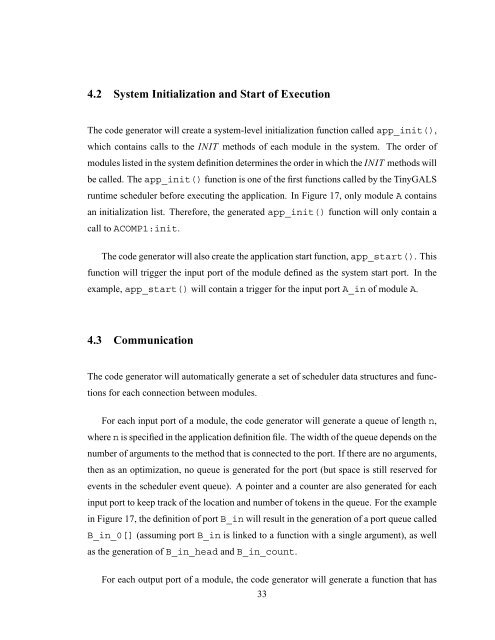Design and Implementation of TinyGALS: A Programming Model for ...
Design and Implementation of TinyGALS: A Programming Model for ...
Design and Implementation of TinyGALS: A Programming Model for ...
You also want an ePaper? Increase the reach of your titles
YUMPU automatically turns print PDFs into web optimized ePapers that Google loves.
4.2 System Initialization <strong>and</strong> Start <strong>of</strong> Execution<br />
The code generator will create a system-level initialization function called app_init(),<br />
which contains calls to the INIT methods <strong>of</strong> each module in the system. The order <strong>of</strong><br />
modules listed in the system definition determines the order in which the INIT methods will<br />
be called. The app_init() function is one <strong>of</strong> the first functions called by the <strong>TinyGALS</strong><br />
runtime scheduler be<strong>for</strong>e executing the application. In Figure 17, only module A contains<br />
an initialization list. There<strong>for</strong>e, the generated app_init() function will only contain a<br />
call to ACOMP1:init.<br />
The code generator will also create the application start function, app_start(). This<br />
function will trigger the input port <strong>of</strong> the module defined as the system start port. In the<br />
example, app_start() will contain a trigger <strong>for</strong> the input port A_in <strong>of</strong> module A.<br />
4.3 Communication<br />
The code generator will automatically generate a set <strong>of</strong> scheduler data structures <strong>and</strong> func-<br />
tions <strong>for</strong> each connection between modules.<br />
For each input port <strong>of</strong> a module, the code generator will generate a queue <strong>of</strong> length n,<br />
where n is specified in the application definition file. The width <strong>of</strong> the queue depends on the<br />
number <strong>of</strong> arguments to the method that is connected to the port. If there are no arguments,<br />
then as an optimization, no queue is generated <strong>for</strong> the port (but space is still reserved <strong>for</strong><br />
events in the scheduler event queue). A pointer <strong>and</strong> a counter are also generated <strong>for</strong> each<br />
input port to keep track <strong>of</strong> the location <strong>and</strong> number <strong>of</strong> tokens in the queue. For the example<br />
in Figure 17, the definition <strong>of</strong> port B_in will result in the generation <strong>of</strong> a port queue called<br />
B_in_0[] (assuming port B_in is linked to a function with a single argument), as well<br />
as the generation <strong>of</strong> B_in_head <strong>and</strong> B_in_count.<br />
For each output port <strong>of</strong> a module, the code generator will generate a function that has<br />
33
















